How did GI Joe become the world’s most successful boys’ toy?
- Published
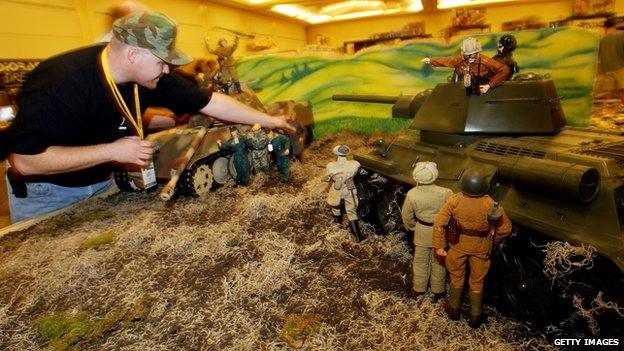
GI Joe's popularity over the years has seen it become the world's most popular toy for boys
As a child, Ace Allgood served in the army on Mondays, chased gorillas on Tuesdays, and went parachuting on Wednesdays.
No, he wasn't the world's most accomplished 10-year-old. His mum just bought him a few GI Joe action figures as a kid.
"GI Joes allowed me to make whatever adventure I wanted," remembers Mr Allgood fondly - a crucial escape, he says, from a lonely childhood.
Since being launched in 1964, hundreds of millions of GI Joes have been manufactured and sold by Rhode Island-based Hasbro. And over those 50 years, hundreds of millions of adventures have been dreamt up by kids like Mr Allgood across the US and the globe.
Gary Cross, a professor of children's history at Pennsylvania State University, says it's the malleability of the GI Joe storyline that has helped it become the most popular boys' toy of the 20th Century.
"It's hard for me to imagine anything that would have had more of an impact [on 20th Century toy design]," says Prof Cross, who was part of a committee that inducted GI Joe into the Toy Hall of Fame, external in 2004.
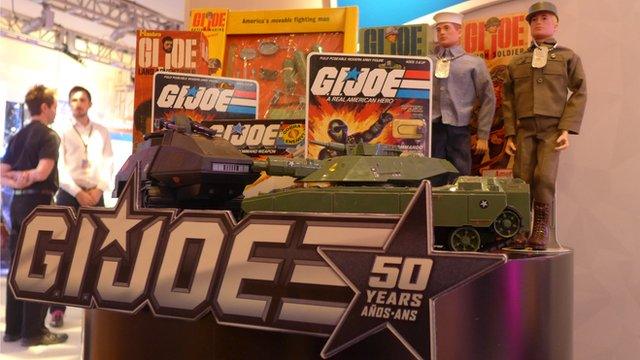
GI Joe celebrates 50 years at the New York Toy Fair this month
Now, as GI Joe celebrates its 50th birthday here on the floor of the New York Toy Fair, the question is: can Hasbro's "real American hero" survive in the 21st Century?
Don't call them 'dolls'
The most successful boys' toy of all time can thank the girls.
After the runaway success of Barbie, launched by Mattel in 1959, executives at rival toy firm Hasbro were scratching their heads, looking for something that might appeal to boys.
Enter Don Levine, a creative director for the company at the time. A former army man himself, Mr Levine decided to create a line of toys for boys modelled after "Government Issued Joes, external" - or the everyday soldiers that served in the US armed forces.
The thought was that they would appeal to a generation of boys whose fathers, uncles, and neighbours had recently fought in either World War II or the Korean War.
Just don't call them dolls.
"The sales force was forbidden to use the term 'doll' - if anyone referred to it as a doll they were fined," says Kirk Bozigian, a former product manager at Hasbro.
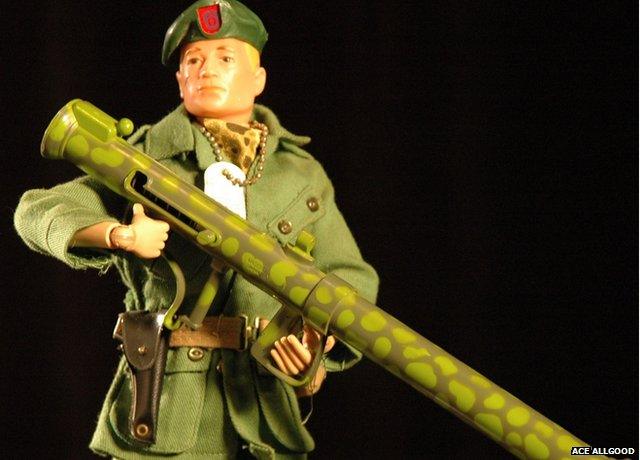
The Green Beret GI Joe was made from 1965-1968 and was meant to appeal to boys whose fathers may have fought
Dubbed "men of action" or action figures, Hasbro chief executive Merrill Hassenfeld decided GI Joe would be the future of the firm, and planned one of the most ambitious launches in toy history.
"Merrill thought his team was on to a magic formula and he decided he was going to stake the future of the company on this endeavour. If it didn't work it was clear that [the company] would have had a hard time recovering," says Derryl DePriest, the current vice-president of marketing for boys at Hasbro.
"But the insights paid off and Hasbro as we know it today is built on the foundation of the success of the original GI Joe."
Saving tigers
But it wasn't plain sailing from 1964 on.
For instance, just a few years after its initial success, American sentiment towards war become more complicated as the Vietnam War ramped up.
"GI Joe more than any other product line has been a product of the influence of the social forces that surround it," says Mr DePriest.
So instead of featuring heroes from the US Army, Navy, Marines, and Air Force, in 1969 Hasbro launched "Adventures of GI Joe", which later became Adventure Team in 1970 - a series of action figures who, instead of fighting in wars, engaged in adventure-oriented missions like saving white tigers.
"The company has been willing in effect to radically change. It hasn't stuck with a simple back story- that explains the long-term survival of it," says Prof Cross.
Everyday hero
Later, in the 1970s, the pressures of the world oil market pushed up the price of plastic, and, rather than raise prices, Hasbro retired the 12-inch GI Joe model in 1976.
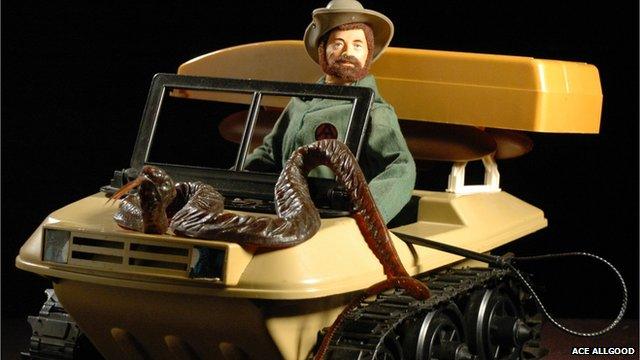
GI Joe moved from a military theme to one focused on adventures like this one for "Coils of Doom" from 1975
But even after retirement, the allure of the "everyday hero" - a toy that didn't have a name or a super power or a predictable story - continued to appeal to Hasbro's designers and marketers.
So a core group of people, including Mr Bozigian and his boss, Bob Prupis, kept tinkering behind the scenes to work out how to bring Joe back.
Inspired by the success of the Star Wars action figures, which were radically smaller at three and three quarter inches, Mr Bozigian pitched the idea of a shrunken GI Joe to his bosses and, later, to the department store Sears Roebuck.
But unlike Star Wars, GI Joe had no specific storyline and executives were sceptical.
So they came up with a novel idea: since they couldn't afford a movie or even a TV show, they would commission Larry Hama at Marvel to write a comic book.
"The secret weapon we had was that we were going to advertise the comic book on television. No comic book had ever been advertised on television before," says Mr Bozigian.
Relaunched in 1982, within a year the company had made more than five times the sales they had initially hoped for - securing GI Joe's future.
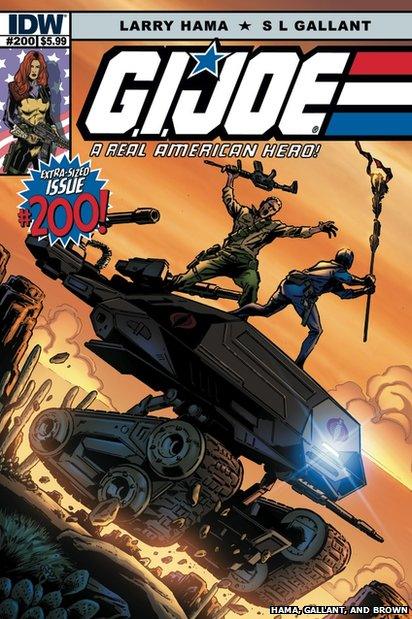
The 200th issue of the GI Joe comic book comes out in March - still written by Larry Hama, it is now published by IDW Publishing
Transformation
Since then, the toy has continually been manufactured in one form or another.
In recent times, the brand's success has been due partly to the release of two GI Joe films, but mainly to a dedicated group of collectors, most of whom are in their 40s and 50s, who grew up playing with the original GI Joes.
Hasbro has acknowledged that the firm's fortunes are no longer tied to GI Joe's success - and that without a big movie event, it is mostly the collectors that keep the brand going.
But even some of those collectors wonder if the toy still holds the same appeal.
Justin Bell has bought a GI Joe every year since 1982 and runs a fan site, GeneralsJoes.com, external. But he cannot convince his eight-year-old daughter to play with the toys.
"These days I do not see an attachment with children as there was back then - there are so many more forms of entertainment for kids," he says.
That's why GI Joe may be in for one more transformation - either through the films, interactive games or new storylines.
"Action figures are going to have to change, they're going to have to adapt to a new world of how kids play," says Mr Bozigian.
But, he adds: "As long as there are boys or children who have imaginations and who want to see their imaginations come to life, I think there will always be a need for action figures."
- Published13 February 2014
- Published27 January 2014
- Published6 November 2013